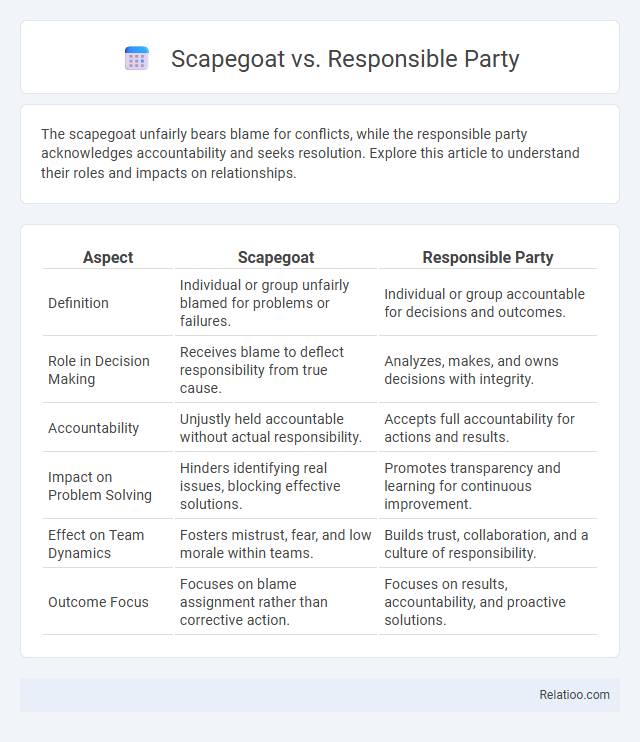The scapegoat unfairly bears blame for conflicts, while the responsible party acknowledges accountability and seeks resolution. Explore this article to understand their roles and impacts on relationships.
Table of Comparison
| Aspect | Scapegoat | Responsible Party |
|---|---|---|
| Definition | Individual or group unfairly blamed for problems or failures. | Individual or group accountable for decisions and outcomes. |
| Role in Decision Making | Receives blame to deflect responsibility from true cause. | Analyzes, makes, and owns decisions with integrity. |
| Accountability | Unjustly held accountable without actual responsibility. | Accepts full accountability for actions and results. |
| Impact on Problem Solving | Hinders identifying real issues, blocking effective solutions. | Promotes transparency and learning for continuous improvement. |
| Effect on Team Dynamics | Fosters mistrust, fear, and low morale within teams. | Builds trust, collaboration, and a culture of responsibility. |
| Outcome Focus | Focuses on blame assignment rather than corrective action. | Focuses on results, accountability, and proactive solutions. |
Understanding the Concept of a Scapegoat
The concept of a scapegoat involves blaming an individual or group for problems or failures often unfairly, diverting attention from the actual responsible party. Unlike the responsible party, who genuinely holds accountability, the scapegoat serves as a convenient target to absorb criticism and avoid addressing systemic issues. Your ability to differentiate between a scapegoat and the true responsible party is crucial for fostering accountability and finding effective solutions.
Defining a Responsible Party
A responsible party is an individual or entity legally accountable for an action or outcome, particularly in contexts like environmental liability or contractual obligations. You must distinguish this party from a scapegoat, who is unfairly blamed to divert attention from the true responsible party. Defining a responsible party involves examining evidence, legal standards, and factual accountability to ensure accurate assignment of responsibility.
Key Differences Between Scapegoat and Responsible Party
The key difference between a scapegoat and a responsible party lies in accountability: a scapegoat is unfairly blamed for problems or mistakes they did not cause, while the responsible party is truly accountable for the issue. Your ability to identify the responsible party ensures that justice is served and that the scapegoat is not unjustly punished. Understanding this distinction helps maintain fairness in conflict resolution and organizational dynamics.
Historical Examples of Scapegoating
Historical examples of scapegoating reveal patterns where marginalized groups like the Jews during medieval Europe and the Tutsi in Rwanda were wrongfully blamed for societal crises or political failures. The responsible parties, often ruling elites or political leaders, deflected accountability by targeting these scapegoats to maintain power and social order. This manipulation of public perception illustrates how scapegoating functions as a tool for avoiding genuine responsibility and perpetuating injustice.
The Role of Accountability in Responsibility
Accountability ensures the responsible party accepts ownership of their actions and outcomes, fostering trust and integrity in personal and professional relationships. You must differentiate between a scapegoat, who unfairly bears blame, and the responsible party genuinely liable for decisions or mistakes. Clear accountability mechanisms prevent misuse of blame and promote ethical responsibility.
Psychological Impact of Being a Scapegoat
Being a scapegoat often leads to significant psychological distress, including feelings of unfairness, low self-esteem, and chronic anxiety, whereas a responsible party typically experiences accountability without the undue burden of misplaced blame. Your mental health can suffer when you are wrongly assigned blame, fostering isolation and resentment that impede emotional well-being and interpersonal trust. Unlike the responsible party who faces consequences related to actual actions, the scapegoat endures relentless guilt and social rejection despite their innocence.
How Organizations Assign Responsibility
Organizations assign responsibility by clearly defining the roles of the responsible party, who is accountable for actions or outcomes, in contrast to the scapegoat, who is unfairly blamed for failures. Effective management ensures your team members are evaluated based on objective performance metrics rather than shifting blame to scapegoats. This approach fosters accountability, improves organizational culture, and drives better decision-making.
Scapegoating in Politics and Society
Scapegoating in politics and society often involves unfairly blaming a scapegoat to divert attention from the responsible party, undermining accountability and hindering problem-solving. This tactic exploits social tensions, causing your community to polarize as fear and misinformation spread. Recognizing scapegoating dynamics helps safeguard democratic processes and fosters informed civic engagement.
Avoiding the Scapegoat Trap: Best Practices
Avoiding the scapegoat trap requires clearly defining roles and responsibilities to ensure accountability without unfairly blaming individuals. Your organization should foster open communication and root cause analysis to identify systemic issues rather than singling out a scapegoat. Implementing transparent feedback mechanisms helps differentiate between the responsible party and someone unfairly scapegoated, promoting a fair and productive work environment.
Cultivating a Culture of True Responsibility
Cultivating a culture of true responsibility requires distinguishing between scapegoats and responsible parties by fostering accountability and transparent communication. Encouraging individuals to own their actions and learning from mistakes promotes organizational growth, while blaming scapegoats undermines trust and efficiency. Implementing clear responsibility frameworks and promoting psychological safety helps create an environment where genuine accountability thrives.

Infographic: Scapegoat vs Responsible Party
 relatioo.com
relatioo.com